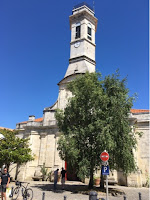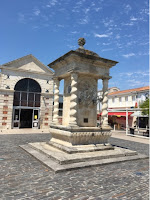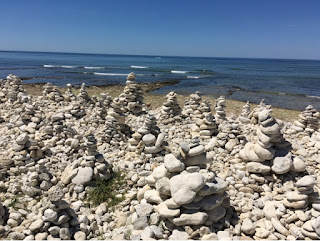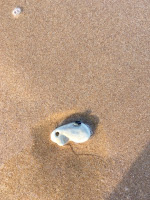 While touring the Île d’Oléron and stopping to explore the village of Saint-Pierre, we were struck by this significant though rather mysterious monument from the Middle Ages.
While touring the Île d’Oléron and stopping to explore the village of Saint-Pierre, we were struck by this significant though rather mysterious monument from the Middle Ages.
 This model so- called lantern of the dead (lanternes des morts oder Totenleuchte) dates from at least the 1150s appear throughout western France, and though the oldest and highest at twenty-eight meters, inland, it was not visible for great distances—mostly on the periphery of cemeteries, as this one is, probably was kept as an eternal flame or lit to recall the parish to funerary rites. No one knows for certain to their custom and origin, however.
This model so- called lantern of the dead (lanternes des morts oder Totenleuchte) dates from at least the 1150s appear throughout western France, and though the oldest and highest at twenty-eight meters, inland, it was not visible for great distances—mostly on the periphery of cemeteries, as this one is, probably was kept as an eternal flame or lit to recall the parish to funerary rites. No one knows for certain to their custom and origin, however.
 Most presume that these free-standing spires were early dedications akin to wayside shrines (Weg- oder Bildstöcke) that commemorate accidents or escapes on pilgrimage routes, but given their sturdiness and clean polygonal symmetries (the church of the village had similar early gothic angles), people entertain all sorts of influences (cheminées sarrasines they are sometimes called perhaps as a memory from the Battle of Tours) and forgotten rituals, perhaps even originally to purpose as warning of quarantine or danger, despite the continuance of history.
Most presume that these free-standing spires were early dedications akin to wayside shrines (Weg- oder Bildstöcke) that commemorate accidents or escapes on pilgrimage routes, but given their sturdiness and clean polygonal symmetries (the church of the village had similar early gothic angles), people entertain all sorts of influences (cheminées sarrasines they are sometimes called perhaps as a memory from the Battle of Tours) and forgotten rituals, perhaps even originally to purpose as warning of quarantine or danger, despite the continuance of history.
Sunday 24 July 2016
art funéraire
catagories: ⚰️, 🇫🇷, architecture, religion, ⓦ
du hast den farbfilme vergessen
Via Der Spiegel (nur auf Deutsche), we are introduced to a demonstration project in artificial-intelligence “deep learning” in the form of an algorithm that can add a splash of colour to black-and-white photographs.
 Like the routine that offers to caption one’s images, the better it gets (provided it is not subject to abuse and ridicule) the more experience it has. It is interesting how when context is available, it’s already very good at inserting the proper soft hue to grass and half-lit canyons, but for historical photographs, things start to fade and come up a wash, as it cannot guess the colour of Kaiser Wilhelm’s dress-coat or differentiate building colour among sepia tones. Give it a try yourself and also help improve the algorithm’s confidence.
Like the routine that offers to caption one’s images, the better it gets (provided it is not subject to abuse and ridicule) the more experience it has. It is interesting how when context is available, it’s already very good at inserting the proper soft hue to grass and half-lit canyons, but for historical photographs, things start to fade and come up a wash, as it cannot guess the colour of Kaiser Wilhelm’s dress-coat or differentiate building colour among sepia tones. Give it a try yourself and also help improve the algorithm’s confidence.
trademark, earmark
Though there is no law proscribing that an American president cannot be engaged in private commercial activity—though most are more discrete about it, having their income tied up in plantations, speakers’ fees, book deals or in other monetary instruments, no other candidate has founded his pre-political career on image and personality so as to seem inexorably inseparable from the brand as our mogul Silvio Berlusconi.
 Notwithstanding the inherent conflict of interest that presents itself when pledging to restrict Muslim immigration despite lending his name to business towers in Istanbul and Dubai, there are a whole array of products, like premium vodka, subscription steak deliveries, cologne, a winery, a diploma-mill in addition to the casinos and beauty-pageants that the candidate might have to divest himself of. With the campaign slogan, “America—you can be my ex-wife,” I wonder who the lucky recipient of this alimony might be. I suspect Berlusconi or a coalition government formed by one of Stevie Nick’s shawls and the scalp of Trump’s own balding pate might make for a more beneficent rule.
Notwithstanding the inherent conflict of interest that presents itself when pledging to restrict Muslim immigration despite lending his name to business towers in Istanbul and Dubai, there are a whole array of products, like premium vodka, subscription steak deliveries, cologne, a winery, a diploma-mill in addition to the casinos and beauty-pageants that the candidate might have to divest himself of. With the campaign slogan, “America—you can be my ex-wife,” I wonder who the lucky recipient of this alimony might be. I suspect Berlusconi or a coalition government formed by one of Stevie Nick’s shawls and the scalp of Trump’s own balding pate might make for a more beneficent rule.
catagories: 🇺🇸, 💱, 📺, food and drink, foreign policy
lustration
While it is probably almost always amateur-night at the False Flag, depending on how chuffed one imagines oneself to be and the target-audience to be duped—despite what the hecklers may counter, the manufactured junta, military coup that the current and long-standing regime of the Turkish government sprung in the midst of tragic distraction and suffering ought to be a cue to the world that this Ottoman cabal ought not be accorded the respect and confidence of a legitimate and democratically sourced power any longer.
 The rolls of undesirables to be purged were at the ready to be released in the immediate aftermath of the orchestrated failure, like the enemies-list of some paranoid Roman emperor (the attested role of country’s military’s executive estate being to preserve the standard of secularism in the face of the blurring of Church and State) and ushered in the lock-down of thousands of educational, judicial, media and charitable institutions accused of subversion, not counting the depleted ranks of the army and untold political dissidents in the sweeping process. The staging of the whole theatre was sloppy—but also was the media coverage and critical-analysis. Such disdain for difference of opinion certainly and basic human-rights could not be the hallmarks of accession to the European Union—not that the muzzled majority of Turkish people should suffer more for the tyranny of their leaders, nor does it seem to be an ideal location for the US to store its nuclear arsenal or consider its NATO partnership a reliable one. Let’s hope that this pretend narrative could lend momentum to the real thing.
The rolls of undesirables to be purged were at the ready to be released in the immediate aftermath of the orchestrated failure, like the enemies-list of some paranoid Roman emperor (the attested role of country’s military’s executive estate being to preserve the standard of secularism in the face of the blurring of Church and State) and ushered in the lock-down of thousands of educational, judicial, media and charitable institutions accused of subversion, not counting the depleted ranks of the army and untold political dissidents in the sweeping process. The staging of the whole theatre was sloppy—but also was the media coverage and critical-analysis. Such disdain for difference of opinion certainly and basic human-rights could not be the hallmarks of accession to the European Union—not that the muzzled majority of Turkish people should suffer more for the tyranny of their leaders, nor does it seem to be an ideal location for the US to store its nuclear arsenal or consider its NATO partnership a reliable one. Let’s hope that this pretend narrative could lend momentum to the real thing.
catagories: 🇹🇷, foreign policy, revolution
house-arrest ou le château d’oléron
 The settlement that has grown over the centuries around Le Château d’Oléron is arguably most famous as the place where Henry II held his troublesome but otherwise irreproachable wife, Eleanor of Aquitaine captive for sixteen years for conniving to replace him as sovereign of England and outremar with their eldest son.
The settlement that has grown over the centuries around Le Château d’Oléron is arguably most famous as the place where Henry II held his troublesome but otherwise irreproachable wife, Eleanor of Aquitaine captive for sixteen years for conniving to replace him as sovereign of England and outremar with their eldest son.

 Surely not the worst of places to wile away one’s sentence, but it turned out to be all the more endearing to us with the hindsight of nine hundred years that we’d visited this place (at least the Vauban fortifications and harbour) a mere five years hence and had forgotten about it—like the Wizard Gandalf said, “I have no memory of this place,” but being as function follows form for citadels, certain patterns start to emerge that tend to blur together.
Surely not the worst of places to wile away one’s sentence, but it turned out to be all the more endearing to us with the hindsight of nine hundred years that we’d visited this place (at least the Vauban fortifications and harbour) a mere five years hence and had forgotten about it—like the Wizard Gandalf said, “I have no memory of this place,” but being as function follows form for citadels, certain patterns start to emerge that tend to blur together.
 Happily we had not remembered as we got to discover more, including the rows of former oyster-mongers bright water-colour shacks that had been conserved and converted to boutiques and studios—which reminded me of the laboratories and dwellings of the court alchemists of Prague whose workshops around the castle were resigned to a similar fate but didn't cost an extra entry fee to see—strongholds of Protestantism where the Huguenots had refuge given the island’s remote location, the Jesuit abbey converted into the Mairie, the city hall and chamber of commerce, and the historic square with a fountain that marked in neo-Renaissance style the inclusion of Île d’Orélon on the circuit of the Tour de France, acknowledged some ninety years after a jibe with competing publishers of a bicycle and a car magazines decided to put rubber to the road.
Happily we had not remembered as we got to discover more, including the rows of former oyster-mongers bright water-colour shacks that had been conserved and converted to boutiques and studios—which reminded me of the laboratories and dwellings of the court alchemists of Prague whose workshops around the castle were resigned to a similar fate but didn't cost an extra entry fee to see—strongholds of Protestantism where the Huguenots had refuge given the island’s remote location, the Jesuit abbey converted into the Mairie, the city hall and chamber of commerce, and the historic square with a fountain that marked in neo-Renaissance style the inclusion of Île d’Orélon on the circuit of the Tour de France, acknowledged some ninety years after a jibe with competing publishers of a bicycle and a car magazines decided to put rubber to the road.  Our bike trekking here, though no where near epic, took us through some really amazing landscapes of the island.
Our bike trekking here, though no where near epic, took us through some really amazing landscapes of the island.
caveat lector
 Though perhaps an object lesson in the reliability of the tabloid-press and this fast-food franchise does carry the daily issue of this particular publication in its restaurants for its diners’ reading pleasure, it seems very tragic that the German outlets would blindly carry this edition the following day after the murderous rampage in Munich, oblivious to the irony. In the main, German journalism is more reserved and sparing on speculation or salacious details (to protect the parties involved) and may never disclose names until one event is overcome by the next catastrophe. ISIS is the Cosplay Caliphate by its nature attracts losers and cowards to its sick and contorted cause, and operating under the principle that there is no such thing as bad publicity, gladly will accept someone settling personal scores under their ægis and allow the media to will connections that may or may not be there.
Though perhaps an object lesson in the reliability of the tabloid-press and this fast-food franchise does carry the daily issue of this particular publication in its restaurants for its diners’ reading pleasure, it seems very tragic that the German outlets would blindly carry this edition the following day after the murderous rampage in Munich, oblivious to the irony. In the main, German journalism is more reserved and sparing on speculation or salacious details (to protect the parties involved) and may never disclose names until one event is overcome by the next catastrophe. ISIS is the Cosplay Caliphate by its nature attracts losers and cowards to its sick and contorted cause, and operating under the principle that there is no such thing as bad publicity, gladly will accept someone settling personal scores under their ægis and allow the media to will connections that may or may not be there.
Saturday 16 July 2016
hühnergott
We discovered on the Atlantic stretch of beach leading to the lighthouse (Phare) of Chassiron on the northernmost tip of the Île d’Oléron thousands of stone piles (cáirn). It was a really arresting and surprising composition, like a landscape from the imagination of Anton Gaudí.  The collected and arranged stones were obliviously bleached and hewn by the sea, pock-marked and made me think of the received folk-belief of the Hühnergotten (equivalent to the Celtic idea of the Adders’ Stone) that a rock with a naturally (or preternaturally) bored hole is a lucky charm—presumably because it can be strung through easily and worn as an amulet.
The collected and arranged stones were obliviously bleached and hewn by the sea, pock-marked and made me think of the received folk-belief of the Hühnergotten (equivalent to the Celtic idea of the Adders’ Stone) that a rock with a naturally (or preternaturally) bored hole is a lucky charm—presumably because it can be strung through easily and worn as an amulet.  Not all of these stones could have been eroded by time and tide to specifications like this one I spied but left on the beach to achieve a perfect poultry-form (I realise that hühn has nothing to do with chicken but it is an association that gets reinforced like Sparkasse as Cheese Bank) as I think that would have been too magical.
Not all of these stones could have been eroded by time and tide to specifications like this one I spied but left on the beach to achieve a perfect poultry-form (I realise that hühn has nothing to do with chicken but it is an association that gets reinforced like Sparkasse as Cheese Bank) as I think that would have been too magical.  I knew, however, that each stone was tending in that direction at least as we stacked and balanced ours along the beach as well before proceeding to the lighthouse and latter day ensemble at the promontory.
I knew, however, that each stone was tending in that direction at least as we stacked and balanced ours along the beach as well before proceeding to the lighthouse and latter day ensemble at the promontory.
catagories: 🇫🇷, 🌍, 🏖, myth and monsters
Thursday 14 July 2016
revenons à nos moutons
With it being Bastille Day, one could be forgiven for taking the title to be one of the rousing but lesser known verses from La Marseille, but it is actually a French idiom to the effect “but we digress,” which sometimes makes an appearance in English too as a turn of phrase.
 From an anonymous medieval play called La Farce de Maître Pathelin, an anti-hero and petty thief tries to confuse a county magistrate trying him for sheep-wrangling but introducing details from a second crime—to which the judge cries “but let us return to our sheep at hand.”
From an anonymous medieval play called La Farce de Maître Pathelin, an anti-hero and petty thief tries to confuse a county magistrate trying him for sheep-wrangling but introducing details from a second crime—to which the judge cries “but let us return to our sheep at hand.”
catagories: 🇫🇷, 💬, holidays and observances









